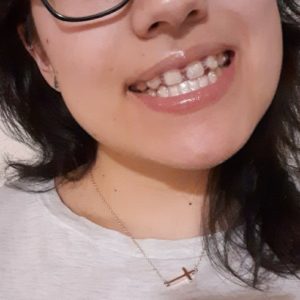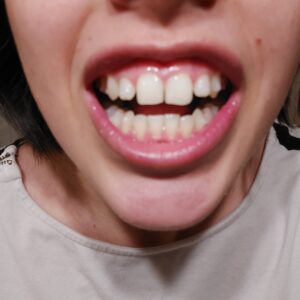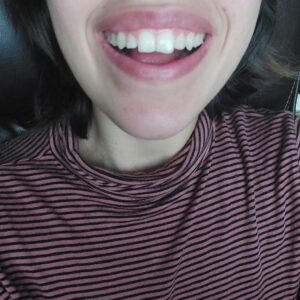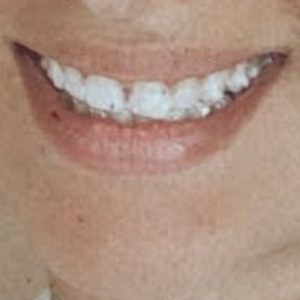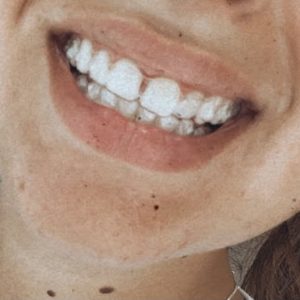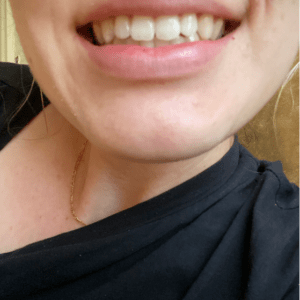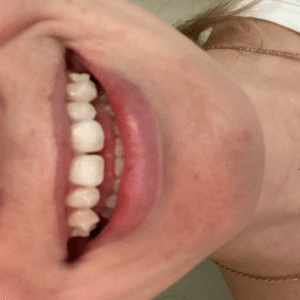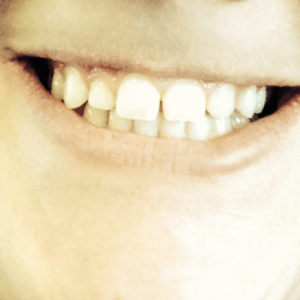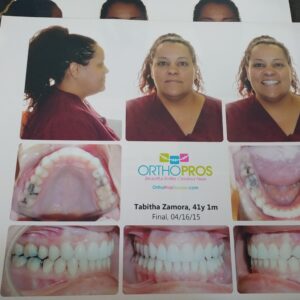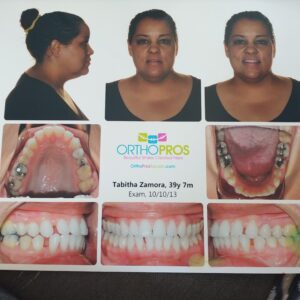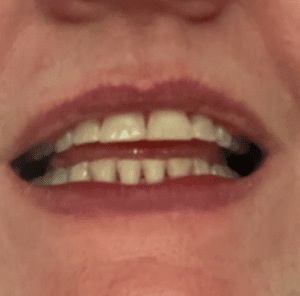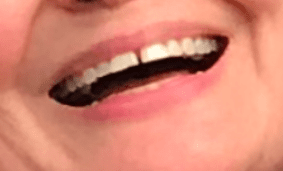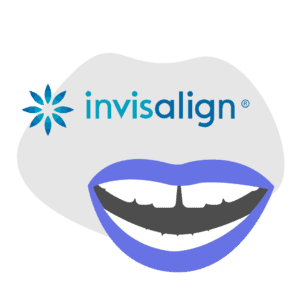
Tooth gaps are rarely serious concerns, but they might make you slightly uncomfortable with your smile. That’s why many adults seek corrective treatment, and there are a ton of treatment options to choose from. Invisalign is among the most popular, but with an average cost of $5,000, this robust treatment system isn’t always the right fit for simple spacing issues.
With this in mind, let’s dig into the details of the Invisalign system and outline a few more affordable alternatives in case it’s not right for you.
Table of Contents
What Art Tooth Gaps?
Tooth gaps, or diastemas, are visible spaces between two or more teeth, most often between the two front incisors (midline diastema). Although “diastema” sounds somewhat serious, these gaps are usually harmless. In fact, people in some parts of the world consider teeth gaps the standard for a beautiful smile. That said, if your tooth gap bothers you for any reason, correcting it is incredibly easy, regardless of your age.
Most cases of diastema don’t come with symptoms, but if your gaps stem from gum disease, however, you may experience gum irritation, redness, or swelling.
Otherwise, you can leave your gaps untreated without affecting your oral health. The primary reason people correct them with orthodontic treatment is because they don’t like how the gaps look.
What Causes Tooth Gaps?
Some of the most common causes are undersized teeth, oversized gums, or missing teeth, which could be genetic or the result of an injury. Other cases come from an oversized labial frenum — the thin piece of tissue connecting your upper lip to your top gums. Dental drifting, which might create gaps, is a sign of advanced gum disease, yet it’s often accompanied by gum irritation, redness, and swelling.
Habits can play a role in forming gaps too. Some children reflexively press their tongues against the roof of their mouths when they swallow, and that consistent pressure can form gaps. Childhood thumb sucking, lip sucking, and tongue thrusting can also contribute.
Can Invisalign Fix Tooth Gaps?
Absolutely. Tooth gaps are a very minor dental issue, typically affecting only a few teeth. In fact, when they’re not accompanied by a bite misalignment or other complication, Invisalign’s “Express” alignment system can be a totally viable treatment method.
Invisalign has been producing impressive treatment results for diastema (and much more complex dental concerns) for over 20 years. And with advances in their technology, their clear aligners have delivered results for patients with a wide range of misalignments. Today, Invisalign is as ubiquitous as traditional braces, particularly for spacing issues.
For cases that call for more complex teeth and jaw movements, dentists can supplement treatment with additions like elastics or Invisalign’s proprietary “Smartforce” attachments. These are discreet tooth-colored shapes your dentist can affix to your teeth to help make more intricate movements. In other words, even if your diastema is accompanied by a more complicated issue (like overjet or crossbite), Invisalign can produce the results you want.
That said, Invisalign isn’t the most affordable option on the market. Even though you might receive insurance coverage (depending on your plan), the average cost of Invisalign is $3,000–$8,000. Yet given their power, quality, and long track record of stunning results, that cost might just be worth it for you.
What’s It Like to Wear Invisalign?
Adults often favor Invisalign over braces because they’re 1) clear, and 2) removable. This means that they’re much less noticeable, and you can take them out to eat, brush your teeth, or attend an important meeting or other special occasion. If your treatment plan includes Smartforce attachments, they’ll stay on the entire time — but again, they’re hardly noticeable.
Invisalign is also typically more comfortable than braces. Since they’re made of plastic, clear aligners irritate the cheeks and tongue far less than metal wires and brackets. Of course, moving your teeth always causes some discomfort, no matter which treatment you pick. But Invisalign offers more comfort and flexibility than conventional braces.
On the flip side, Invisalign treatment requires a lot more discipline than traditional braces. Since Invisalign trays are removable, you have to wear them for 22 hrs each day to align your teeth and jaws successfully. If you’re not motivated enough to play through the pain for the long-term payout — or frequently forget to wear them — Invisalign might be TOO flexible of an option for you.
If you think you’d have trouble integrating Invisalign into your day-to-day routine, consider braces instead. These days, there are many more options available than the traditional metal braces you remember from your childhood. We cover the types of braces that exist today (and much more) in our guide to correcting tooth gaps with braces.
But if you’ve read this far and you’re intrigued by Invisalign, check out our in-depth review for all the info you need to decide if they’re right for you.
Alternative Invisible Aligners
While Invisalign pioneered the mass-market clear aligner and remains among the most popular providers out there, there are a few other clear aligner brands that we think present intriguing alternatives. Plus, there’s a whole new industry on the rise for at-home teeth aligners that don’t require a single trip to the dentist.
Whether you’re simply interested in an alternative clear aligner brand or you’re looking to correct your open bite from home, there’s most likely a solution on this list for you. Below, we’ve broken down some of the most popular alternatives to Invisalign.
In-Office Brands
Align Tech (the makers of Invisalign) is no longer the only company that partners with dentists and orthodontists to provide treatment with clear aligners. These treatments also include regular in-person care from your dentist or orthodontist, and they can all incorporate attachments and appliances to correct more complex jaw misalignments like open bite.
- ClearCorrect: Founded in 2006, ClearCorrect isn’t as experienced as Invisalign, but they’ve still been delivering quality results for over a decade. They typically charge dentists and orthodontists less for lab fees, which can make their aligners slightly more affordable. Plus, they have multiple treatment plans — including one where you pay per aligner — so they can tailor your plan to your condition.
Check out our full ClearCorrect review to learn more.
- SureSmile: Another one of Invisalign’s oldest competitors, SureSmile launched its clear aligners in 2007. It can treat the same scope of misalignments as Invisalign, and the company says that their patients are less likely to need refinements after treatment. Despite this, they boast lower prices and, since they don’t have a specific mandatory scanner, providers can save money and pass those savings on to you.
Interested? Read through our complete SureSmile review for more.
- 3M Clarity Aligners: 3M — the company behind Scotch Tape and Post-Its — creates clear aligners with incredible teeth-moving power thanks to their unique attachment placement and two different proprietary materials. Since 3M also makes Clarity Clear Braces, orthodontists have the choice of designing a combination treatment that uses them simultaneously with aligners.
Our full 3M Clarity Aligners review has a ton more information.
Home Invisible Aligners
These companies have taken Invisalign’s model and made it more convenient by delivering everything straight to your home. Like Invisalign, you’ll receive a set of clear, removable aligners customized to your teeth by a dental professional. But unlike Invisalign, they don’t require any trips to the dentist’s office — and treatment often costs a lot less.
They can’t handle severe misalignments or significant bite issues, but they’re solid, affordable choices for milder cases.
- Byte: Byte claims an average treatment plan length of just 4–5 months, and with every aligner package, they include their HyperByte — a high-frequency vibration device to better seat your aligners for a more comfortable aligner fit and possibly faster dental shifts. Plus, they put a lifetime guarantee on your smile, and for those who’d prefer to straighten their teeth at night, they offer “At-Night” aligners designed with plastic selected specifically to withstand nighttime teeth grinding.
See our comprehensive review of Byte for an in-depth look at their services.
- Candid: Candid started as a fully remote clear aligner service, but they’ve since shifted to a hybrid treatment that combines elements of in-office and at-home care. After an initial in-person consultation and examination with a local dentist, you’ll check in virtually via their CandidMonitoring service every 14 days for the rest of your treatment. It usually costs $3,500 or more, but you’ll get a higher level of care than other at-home options.
Our complete Candid review has a lot more important information.
- SmileDirectClub: SmileDirectClub was one of the first companies to offer at-home clear aligner treatment and continues to be the most popular option. Founded in 2014, SmileDirectClub has treated over 1.5 million patients to date. With SmileShops across the country where you can get a free teeth scan, they’ve also gone the extra mile to make the treatment process as convenient as possible. Plus, they have a lifetime smile guarantee and extensive refund policies.
Check out our SmileDirectClub review for a deep dive into their treatment.
Other Treatment Options
Braces
If you think you’d have trouble integrating Invisalign into your day-to-day routine, it might be worth considering braces instead. Braces are one of the most trusted and time-tested treatment options for teeth spacing. Adults might shy away from the metal brackets involved, but their transformative results are undeniable. Not to mention that recent dental technology has given rise to new, less visible styles, like clear braces that blend in with your teeth and lingual braces that are positioned behind them.
Traditional braces generally take 12–30 months and cost $3,000–$7,000 to achieve the desired results. However, teeth spacing cases are usually much simpler than bite misalignments, so they often fall into the lower end of both ranges. Read more about types, outcomes, and much more in our guide to correcting tooth gaps with braces.
Traditional Veneers
Veneers can be a good option for anyone looking to transform their smile without physically shifting their teeth. These thin, strong porcelain shells are affixed to the front of your teeth, giving your smile an immediate makeover.
Adults that have less severe cases of spacing can get veneers to achieve visually impressive results. They give the appearance of a straight, gapless smile without the discomfort and time commitment of braces or aligners. On the downside, they don’t solve the underlying issue and veneers’ average lifespan is 7–20 years before you need to replace them. Also, the typical price of veneers is $500–$2,000 per tooth, so it’s worth considering whether you would rather put that money toward a more permanent fix.
Snap-On Veneers
If you like the idea of an instant smile transformation, but the permanence of traditional veneers worries you, snap-on veneers could be a great option. These removable appliances clip onto your teeth, hiding your gaps, along with stains, cracks, chips, missing teeth, and other cosmetic issues.
Companies like Shiny Smile and Removable Veneers USA customize these veneers using molds of your teeth, so they’re a perfect match. They often come in different shades and models — some for everyday use and others for occasional wear.
Snap-on veneers are much more affordable than traditional veneers and many orthodontic treatments, but they’re also not permanent, and they can be slightly uncomfortable to wear. That said, they’re a solid choice for people seeking a quick and inexpensive solution. Check out our guide to the five best snap-on veneers to learn more.
Bonding
For very minor cases, specifically ones only involving the front four teeth, dentists can use a moldable, putty-like substance — very similar to cavity fillings — to fill in the gaps. Once the spaces are filled, the dentist uses ultraviolet light to harden the substance. Dental bonding is both strong and durable, but like veneers, it doesn’t solve the underlying orthodontic issues, and it isn’t a permanent solution. Still, it could be a desirable option if your teeth spacing is mild and confined to just a few teeth.
Final Thoughts
Adults with minor dental concerns such as tooth gap have turned to Invisalign time and time again because of the treatment’s flexibility, low profile, and proven results. However, Invisalign is no longer the only treatment method with these qualities, and it’s certainly not the most affordable one in the bunch.
As you consider potential treatments, weigh the pros and cons of each and measure them against your unique dental and financial circumstances. It’s also a good idea to consult a dentist for an analysis of your particular condition. With a professional opinion and some independent research in your back pocket, you’ll be able to choose the path that best suits you — even if that means not pursuing treatment at all.
Frequently Asked Questions
What is a diastema?
Diastema is the medical term for a gap or spacing between two teeth. These gaps can be of any size and between any two teeth, but in most cases, they are narrow and between the two front teeth.
Is it problematic to have a tooth gap?
A gap on its own is not a health concern, though for you, it could be a cosmetic one. However, a gap could indicate crowding in the other teeth or even more severe misalignments. If you have teeth spacing, see a dentist or orthodontist to make sure there are no larger issues present.
Why did I develop a tooth gap as an adult?
It usually comes down to one of two reasons: periodontal disease, and not wearing retainers after previous orthodontic treatment. For the first, you will need extensive oral healthcare treatment before you can address the spacing. With the second, you’ll likely just need some refinement aligners or braces — but wear your retainer after!
Are braces the best option for closing a gap?
In some cases, yes, but in most, no. Usually, teeth spacing is a minor issue that you can easily correct with aligners, which many adults prefer.
How long would I wear braces when correcting a tooth gap?
It varies between patients. If you need to move multiple teeth and have a large gap, it will probably take longer than if you only needed to move two teeth to close a minor one.
Do clear aligners hurt?
Any appliance that moves the teeth has to place pressure on them, and this leads to soreness, especially when biting or chewing. Braces can be more painful than aligners because they’re hard metal and stick out from the teeth, so they can irritate the mouth’s soft tissues.
How often will I need to change my aligners?
Most people change to the next in the series every 1–2 weeks
Am I better off with Invisalign over braces?
Both are great options for closing a tooth gap. The right choice for you depends on your preferences.
Will I need to wear a retainer after closing my gap?
Yes. You will start out wearing your retainer full time, then only at night, then only every couple of days, so it will always be in your life, just not a daily or nightly concern.


